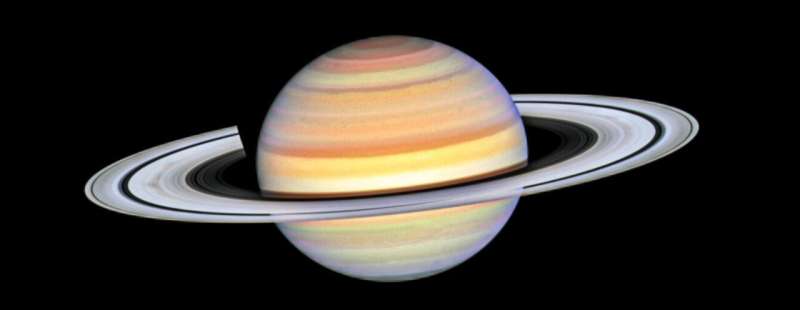This article has been reviewed according to Science X's editorial process and policies. Editors have highlighted the following attributes while ensuring the content's credibility:
fact-checked
trusted source
proofread
NASA's Hubble watches 'spoke season' on Saturn

Though Saturn's unusual-looking "cup handle" features were first noted by Galileo in 1610, it would be another 45 years before they were described by Christiaan Huygens as a disk surrounding Saturn. Subsequently, ground-based telescopes could only distinguish four unique concentric rings, labeled A, B, C, and D.
Not until the 1980s did NASA's two Voyager probes fly by Saturn to photograph thousands of concentric ringlets. An even bigger surprise to Voyager scientists was dark, radial spoke-like patterns in the ring plane that came and went as they revolved around Saturn.
Over the past three decades, the Hubble Space Telescope has picked up where the Voyagers have left off. Hubble's ultra-sharp vision is the next best thing to being there. Hubble follows the ring-spoke "merry-go-round" every year. It's believed the dark spokes are dust particles electrostatically levitated above the ring plane. They seem to change in abundance with Saturn's seven-year-long seasons. And this may be linked to changes in Saturn's magnetic field, as it is battered by the solar wind.
This photo of Saturn was taken by NASA's Hubble Space Telescope on October 22, 2023, when the ringed planet was approximately 850 million miles from Earth. Hubble's ultra-sharp vision reveals a phenomenon called ring spokes.
Saturn's spokes are transient features that rotate along with the rings. Their ghostly appearance only persists for two or three rotations around Saturn. During active periods, freshly formed spokes continuously add to the pattern.
In 1981, NASA's Voyager 2 first photographed the ring spokes. NASA's Cassini orbiter also saw the spokes during its 13-year-long mission that ended in 2017.
Hubble continues observing Saturn annually as the spokes come and go. This cycle has been captured by Hubble's Outer Planets Atmospheres Legacy (OPAL) program that began nearly a decade ago to monitor weather changes on all four gas-giant outer planets.
Hubble's crisp images show that the frequency of spoke apparitions is seasonally driven, first appearing in OPAL data in 2021 but only on the morning (left) side of the rings. Long-term monitoring show that both the number and contrast of the spokes vary with Saturn's seasons. Saturn is tilted on its axis like Earth and has seasons lasting approximately seven years.
"We are heading towards Saturn equinox, when we'd expect maximum spoke activity, with higher frequency and darker spokes appearing over the next few years," said the OPAL program lead scientist, Amy Simon of NASA's Goddard Space Flight Center in Greenbelt, Maryland.
This year, these ephemeral structures appear on both sides of the planet simultaneously as they spin around the giant world. Although they look small compared with Saturn, their length and width can stretch longer than Earth's diameter!
"The leading theory is that spokes are tied to Saturn's powerful magnetic field, with some sort of solar interaction with the magnetic field that gives you the spokes," said Simon. When it's near the equinox on Saturn, the planet and its rings are less tilted away from the sun. In this configuration, the solar wind may more strongly batter Saturn's immense magnetic field, enhancing spoke formation.
Planetary scientists think that electrostatic forces generated from this interaction levitate dust or ice above the ring to form the spokes, though, after several decades, no theory perfectly predicts the spokes. Continued Hubble observations may eventually help solve the mystery.
The Hubble Space Telescope is a project of international cooperation between NASA and ESA. NASA's Goddard Space Flight Center in Greenbelt, Maryland, manages the telescope. The Space Telescope Science Institute (STScI) in Baltimore, Maryland, conducts Hubble and Webb science operations. STScI is operated for NASA by the Association of Universities for Research in Astronomy, in Washington, D.C.
Provided by NASA





















